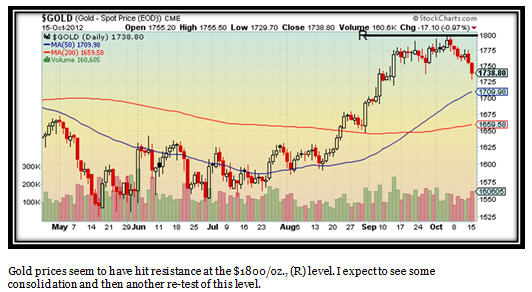When the price of gold is sold-off on Comex, use these dips to buy more physical
After failing to break above the $1800 an ounce level, gold prices came under some selling-pressure last week to trade lower and off its recent highs. The price of the yellow metal closed out the week at $1754.30 an ounce down 2% from last weeks’ high as the US dollar gained against a basket of other major currencies.
On Monday, the price of gold fell by another 1% to $1,727.50 an ounce, the lowest level since September 13. The price of spot came under some selling pressure almost as soon as the US session on Comex began. Prices fell by around $20 an ounce in the first two hours of trading on Comex, to make an intra-day low of $1727.50 an ounce. But, as we all know, the prices traded on the US futures markets do not really reflect the real situation in the gold markets as the bullion banks are allowed to sell as many paper contracts as they wish thus creating an artificial supply scenario. And, while the CFTC do not see the need the need for position limits in precious metals, they recently fined JPMorgan Chase Bank $600,000 as it violated cotton futures position limits. According to the CFTC, the bank’s positions in cotton futures traded on the Intercontinental Exchange U.S. exceeded limits on several days between September 16 and October 5, 2010.
Frankly, as an investor I don’t pay much attention to these price dips as nothing has changed in the fundamentals pushing gold prices higher. And, I think these dips should be used to accumulate more of the physical metal. Obviously, if you are long and are using leveraged instruments such as futures, these short-term drops can really cause some pain. So, entry levels and stop losses are critical.
Since the financial crisis of 2008, the global economic condition has deteriorated considerably. Also, financial and monetary conditions have gotten a lot worse. And, in addition, global unrest is increasing especially in the Middle East. And, none of these issues look as if they are going to improve for a long time to come. This being the case, it is difficult to understand why the price of gold is not a lot higher. However, things become a lot clearer when you watch the daily action in the global gold markets.
As the fundamentals behind the higher gold have not changed, it is reasonable to assume that the prices should edge up higher despite periods of consolidation. One thing that is very noticeable in the gold market is that most of the selling pressure comes towards the opening of Comex. This is the market where there is a massive dislocation between the amount of physical gold available and the amount of gold traded on futures contracts. This is where the bullion banks can sell as many paper contracts as they like, with no limit. And, by doing this they create an artificial imbalance in the real supply and demand fundamentals. But, in spite of all their efforts to cap the gold price at certain levels, the fact remains that demand for physical gold is very robust. Ultimately, as more and more individuals and central banks load up on gold, prices will go higher. So, the good news about the on-going price manipulation on Comex is that by attempting to cap prices, the perpetrators are giving many people the opportunity to buy at the current levels which will look like bargain prices in a few years’ time.
While the financial leaders of the world united to resolve the global financial crisis S&P downgraded the Spain’s sovereign credit rating to BBB-, from BBB+, placing it only one notch above junk.
In a statement S&P stated that the downgrade “reflects our view of the significant risks to Spain’s economic growth and budgetary performance, and the lack of a clear direction in Eurozone policy.” S&P also mentioned that the “the deepening economic recession is limiting the Spanish government’s policy options.”
And, today Standard & Poor’s cut its credit ratings on Banco Santander and Banco Bibao Vizcaya Argentari, Spain’s largest lenders, along with nine other banks after lowering the country’s sovereign rating. Earlier this month, S&P cut Spain’s debt rating to one level above junk. But, only two weeks ago, European Central Bank President Mario Draghi praised Spain’s for its efforts to get its deficit under control. At a news conference, the ECB chief said that “significant progress has taken place” in Spain, adding that a number of measures had been “announced, legislated, and implemented” in only a short period of time. Obviously Standard and Poor’s are not seeing the same progress as Draghi.
During last week, members of the IMF-World Bank met in Tokyo to discuss the worlds’ economic and financial woes. The International Monetary Fund IMF Managing Director Christine Largarde made it very clear that global growth is much slower than anticpated and is not rising fast enough to create jobs for nations.
The IMF also stated that Europe must do more to tackle its fiscal crisis. Despite some new policy measures, among them a bond-buying programme aimed at helping debt-riddled nations tame their borrowing costs, the risks of a world credit crunch and recession loom, the IMF said in a new report.
According to the IMF’s Global Financial Stability Report, “Risks to global financial stability have increased and financial markets have been volatile as European policy-makers grapple with the on-going crisis.” The report’s recommendations include cutting public debt and deficits “in a way that supports growth” and a “clean-up of the banking sector, including recapitalising or restructuring viable banks and resolving non-viable ones”.
In the report the IMF expressed its concern about the situation in the Eurozone and believes that as much as US$ 4.5 trillion will be needed through 2013 so as to achieve its fiscal target. It stated that “intensification of the crisis has manifested itself in capital outflows from the periphery to the core at a pace typically associated with currency crises or sudden stops”.
It also warned that a “further deterioration in the euro area crisis is the biggest risk to global financial stability, but rising imbalances elsewhere are also a cause for concern”.
The IMF lowered estimates of global GDP to 3.3% for this year and 3.6% for 2013 which was revised down from the previous projections of 3.5% in 2012 and 3.9% in 2013, made in July this year. The IMF said that global recovery “has suffered new setbacks, and uncertainty weighs heavily on the outlook.” The IMF also believe that the downside risks to the global economy have increased considerably and any improvement will largely depend on how quickly European and US policy makers can deal with their major short-term economic challenges.
The IMF maintains that Asian growth will improve gradually and that the region will remain the leader in growth. Growth is Asia is estimated to be at 5.4% this year, around 0.6% lower than April’s forecast. Growth projection for China was also lowered to 7.8% in 2012 and 8.2% in 2013.
Last month the European Central Bank announced a programme to buy the government bonds of debt-ridden Eurozone nations provided that they complied with certain strict conditions. And, last Monday, the Eurozone launched its much-awaited 500-billion-euro ($643 billion) European Stability Mechanism rescue fund, which is seen as a major step in the bloc’s defences against a debt crisis that has pushed it back into recession.
Meanwhile, strikes at gold mines in South Africa continue. The Chamber of Mines in South Africa said that striking South African gold miners have refused the industry’s latest pay rise offer. The chamber also said the industry was unable to make any further proposals and companies in the sector, which include AngloGold Ashanti, Gold Fields and Harmony, would have to explore other avenues to stabilise the industry.
Gold Fields has suspended all output at its KDC operations in South Africa after 8,500 more workers joined an illegal strike KDC includes the KDC West and East mines. Around 19,500 of the operation’s total workforce of around 26,700 are now part of the wildcat strike
Since August almost 100,000 workers across South Africa – including 75,000 in the mining sector – have downed tools in often illegal and violent strikes that may hit economic growth this year and undermine investor confidence in the minerals hub.
Africa’s top two bullion producers AngloGold Ashanti and Gold Fields have been hit by an estimated 48,000 miners taking to the streets fighting for higher wages.
Finally someone out there makes sense. And, once again it is Ron Paul. An article of his was published in the Daily Bell on October 09. It should have been published by all the main stream media worldwide. Here is what he wrote:
Government does not create resources when it taxes people and prints money; it merely redistributes the wealth, while supporting a massive, wasteful bureaucracy along the way. Government is a giant, blood-sucking parasite on our otherwise healthy economy. For too long we have entrusted too much economic power and influence to irresponsible politicians in Washington. It’s the chaos that ensues after they run the system into the ground that will be so painful for so many people. But realigning our economy with the free market and away from government mandates and hand-outs must happen in order for it to thrive again.
The answer is not to keep asking government to do more. The answer is to extricate our economy and ourselves from the grasp of Washington DC as much as possible now, before our dependency becomes our downfall.
TECHNICAL ANALYSIS
About the author
David Levenstein is a leading expert on investing in precious metals . Although he began trading silver through the LME in 1980, over the years he has dealt with gold, silver, platinum and palladium. He has traded and invested in bullion, bullion coins, mining shares, exchange traded funds, as well as futures for his personal account as well as for clients.
His articles and commentaries on precious metals have been published in dozens of newspapers, publications and websites both locally as well as internationally. He has been a featured guest on numerous radio and TV shows, and is a regular guest on JSE Direct, a premier radio business channel in South Africa. The largest gold refinery in the world use his daily and weekly commentaries on gold.
David has lived and worked in Johannesburg, Los Angeles, London, Hong Kong, Bangkok, and Bali.
For more information go to: www.lakeshoretrading.co.za
Information contained herein has been obtained from sources believed to be reliable, but there is no guarantee as to completeness or accuracy. Any opinions expressed herein are statements of our judgment as of this date and are subject to change without notice.
{{ commodity.name }}
{{ post.title }}
{{ post.date }}


Comments